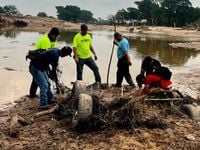Central Texas continues to grapple with the devastating aftermath of the catastrophic flooding that began early on July 4, 2025, in the Texas Hill Country. As of mid-July, the death toll has tragically reached 134, with Kerr County bearing the brunt of the disaster, reporting 107 confirmed fatalities, including 37 children. The number of people still missing stands at 101, underscoring the ongoing urgency of search and recovery efforts.
The flooding, described as far more severe than the 100-year event anticipated by the Federal Emergency Management Agency (FEMA), struck with little warning in the early hours of Independence Day. Waters of the Guadalupe River surged rapidly, rising 26 feet and sweeping away homes, vehicles, and tragically, lives. Among the hardest hit was Camp Mystic, a century-old, all-girls Christian summer camp situated along the river, where at least 27 campers and counselors lost their lives.
Search and rescue operations have been relentless but hampered by persistent heavy rains and the challenging terrain. Authorities have had to intermittently pause efforts due to flash flood watches and rising water levels, particularly along the Guadalupe River near Kerrville. On July 14 and 15, for instance, search crews were pulled back as rainfall rates threatened to exceed two inches per hour, with some areas facing up to six inches of rain. This unpredictable weather has forced teams to repeatedly move to higher ground for safety, delaying critical recovery work.
Kerr County Sheriff Larry Leitha noted that crews lost half to three-quarters of their search day on July 13 due to heavy rains, a setback that reflects the ongoing difficulties in the field. Despite these challenges, more than 2,000 people, including volunteers and professionals, remain committed to the painstaking work of locating victims and providing closure to grieving families. The Federal Emergency Management Agency’s Urban Search and Rescue teams have fully resumed operations as weather permits, and volunteer groups like Lone Star Search and Recovery have shifted efforts to clearing debris when recovery operations are paused.
The United Cajun Navy, a nonprofit volunteer organization based in Baton Rouge, Louisiana, has also answered the call, deploying approximately three dozen volunteers to assist in the search and recovery. Founded after Hurricane Katrina in 2005, the organization has become a vital part of disaster response nationwide. Brian Trascher, the group's national vice president, described the Texas Hill Country flood as particularly challenging due to the terrain and the volume of debris, emphasizing the physical and emotional toll on volunteers. The United Cajun Navy plans to host a benefit concert for flood relief in Kerr County on August 31, aiming to raise funds to support ongoing efforts.
Local officials have faced scrutiny over the adequacy of flood warnings and emergency response. Questions have surfaced about whether residents, especially those at vulnerable locations like Camp Mystic, received timely alerts. While Kerr County has used the CodeRed phone notification system since 2009, reports indicate inconsistencies in alert distribution, complicated by spotty cellphone coverage in some areas. Audio obtained by local media revealed delays and bureaucratic hurdles in issuing alerts, with some messages sent only after supervisors’ approval. Texas Governor Greg Abbott acknowledged the difficulty in accurately accounting for missing persons, noting that some reported missing may not have been swept away by the storm.
Officials from Kerrville and Kerr County have defended their response, emphasizing the unprecedented speed and severity of the floodwaters. Dalton Rice, Kerrville city manager, reflected on the rapid onset of the disaster: "It happened so rapidly that nobody, nobody could have anticipated it." He and other officials highlighted the establishment of an emergency operations center shortly after the flood to coordinate rescue and recovery efforts. State Representative Wes Virdell praised the efficiency of interagency cooperation despite the disaster’s scale.
However, the emotional toll on officials and first responders is palpable. Kerr County Commissioner Rich Paces revealed he has received death threats amid public frustration, lamenting the "blame game" overshadowing the community’s resilience and the support pouring in from across the nation. Governor Abbott expressed gratitude for assistance from at least 25 states, underscoring the unity transcending political divides in times of crisis.
Looking ahead, officials are considering measures to mitigate future disasters. Proposals include constructing more diversion dams to manage floodwaters, establishing a permanent emergency operations center for coordinated responses, and improving cellphone coverage in remote areas. Virdell also mentioned exploring satellite communication to enhance alert systems. Yet, many acknowledge that even with improved infrastructure, the swift and overwhelming nature of the July 4 flood presented near-impossible challenges.
Meanwhile, Central Texas braces for one final day of potential flooding before a drier weather pattern settles in. A Flood Watch remains in effect through July 15, with forecasts warning of heavy downpours and rainfall rates between one and three inches per hour in some areas. The Guadalupe River near Hunt, Texas, has already seen minor flooding, with expectations of moderate flooding as water levels continue to rise. Swift water rescue teams have been pre-positioned in anticipation of possible flooding along other rivers, including the Frio River.
Despite the setbacks, search and rescue teams remain determined. As Ingram Volunteer Fire Department spokesperson Levi Bizzell put it, "Everybody here wants to be out there working. They literally come in in the morning whether they are tired or not, and they just want to get out there and work because they want to find closure for these families." Memorial services are taking place across Texas this week, honoring the victims and supporting the grieving communities.
The scale of the tragedy and the ongoing recovery efforts highlight Texas’s vulnerability to floods, a state that leads the nation in flood-related deaths due to its geography, size, and population. From 1959 to 2019, Texas recorded over 1,000 flood-related fatalities, a sobering statistic underscoring the need for continued vigilance and investment in disaster preparedness.
As the waters recede and the rain finally subsides, Central Texas faces a long road to healing and rebuilding. But amid the sorrow, the tireless efforts of emergency crews, volunteers, and community members embody a resilient spirit determined to weather this storm and prepare for the next.



